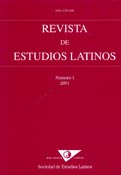Latin Grammar Masters in La Mancha at the Beginning of the XVIIth Century: between Nebrija and Brocense
DOI:
https://doi.org/10.23808/rel.v7i0.87888Keywords:
History; Grammar; seventeenth Century.Abstract
The Latin Grammar masters who guide the schools in La Mancha all throughout XVIIth century move between two opposite positions: on one side they follow the official grammar text at that moment, which is the one from Nebrija and that was reformed by Juan Luis de la Cerda, and, on the other side, they make comments to this official text; in these comments they introduce some modern doctrine manly based on Brocense’s work. This is what Collado Peralta and Caro y Cejudo make. Before them, Jiménez Patón writes a Castilian grammar Institution, where he partly copies to the master from Brozas. However, there is a clear difference between Patón and the first two authors: the first two admit, and they say so, that they follow modern masters, and particularly Brocense; Jiménez Patón, however, clearly copies Brocense, but he does not confess so and presents what he copies as if it were his own work, appropriating this way a novelty sensation that is not so.
Downloads
Downloads
Published
How to Cite
Issue
Section
License
Copyright (c) 2007 Revista de Estudios Latinos

This work is licensed under a Creative Commons Attribution-NonCommercial-NoDerivatives 4.0 International License.
The originals published in the printed and electronic editions of this journal are the property of the Revista de Estudios Latinos and can be circulated as long as the original source and authorship is made clear in any reproduction, full or partial, of the same, and as long as this is not done for commercial purposes.






